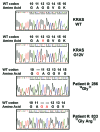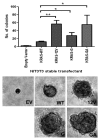Characterization of rare transforming KRAS mutations in sporadic colorectal cancer
- PMID: 24642870
- PMCID: PMC4049792
- DOI: 10.4161/cbt.28550
Characterization of rare transforming KRAS mutations in sporadic colorectal cancer
Abstract
KRAS mutational status has been shown to be a predictive biomarker of resistance to anti-EGFR monoclonal antibody (mAb) therapy in patients with metastatic colorectal cancer. We report the spectrum of KRAS mutation in 1506 patients with colorectal cancer and the identification and characterization of rare insertion mutations within the functional domain of KRAS. KRAS mutations are found in 44.5% (670/1506) of the patients. Two cases are found to harbor double mutations involving both codons 12 and 13. The frequencies of KRAS mutations at its codons 12, 13, 61, and 146 are 75.1%, 19.3%, 2.5%, and 2.7%, respectively. The most abundant mutation of codon 12 is G12D, followed by G12V and G12C while G13D is the predominant mutation in codon 13. Mutations in other codons are rare. The KRAS mutation rate is significantly higher in women (48%, 296/617) than in men (42.1%, 374/889, P = 0.023). Tumors on the right colon have a higher frequency of KRAS mutations than those on the left (57.3% vs. 40.4%, P<0.0001). Two in-frame insertion mutations affect the phosphate-binding loop (codon 10-16) of KRAS are identified. One of them has never been reported before. Compared with wild-type protein, the insertion variants enhance the cellular accumulation of active RAS (RAS-GTP) and constitutively activate the downstream signaling pathway. NIH3T3 cells transfected with the insertion variants show enhanced anchorage-independent growth and in vivo tumorigenicity. Potentially these mutations contribute to primary resistance to anti-EGFR mAb therapy but the clinical implication requires further validation.
Keywords: KRAS; colorectal cancer; targeted therapy.
Figures




Similar articles
-
KRAS codon 61, 146 and BRAF mutations predict resistance to cetuximab plus irinotecan in KRAS codon 12 and 13 wild-type metastatic colorectal cancer.Br J Cancer. 2009 Aug 18;101(4):715-21. doi: 10.1038/sj.bjc.6605177. Epub 2009 Jul 14. Br J Cancer. 2009. PMID: 19603018 Free PMC article.
-
[Correlation between KRAS mutations and clinicopathologic features in colorectal carcinomas].Zhonghua Bing Li Xue Za Zhi. 2012 Sep;41(9):595-8. doi: 10.3760/cma.j.issn.0529-5807.2012.09.005. Zhonghua Bing Li Xue Za Zhi. 2012. PMID: 23157826 Chinese.
-
Association of KRAS p.G13D mutation with outcome in patients with chemotherapy-refractory metastatic colorectal cancer treated with cetuximab.JAMA. 2010 Oct 27;304(16):1812-20. doi: 10.1001/jama.2010.1535. JAMA. 2010. PMID: 20978259
-
Multiple mutations in the Kras gene in colorectal cancer: review of the literature with two case reports.Int J Colorectal Dis. 2011 Oct;26(10):1241-8. doi: 10.1007/s00384-011-1238-0. Epub 2011 May 21. Int J Colorectal Dis. 2011. PMID: 21603900 Review.
-
KRAS p.G13D mutation and codon 12 mutations are not created equal in predicting clinical outcomes of cetuximab in metastatic colorectal cancer: a systematic review and meta-analysis.Cancer. 2013 Feb 15;119(4):714-21. doi: 10.1002/cncr.27804. Epub 2012 Sep 12. Cancer. 2013. PMID: 22972628 Review.
Cited by
-
Oncogene Mutations in Colorectal Polyps Identified in the Norwegian Colorectal Cancer Prevention (NORCCAP) Screening Study.Clin Med Insights Pathol. 2016 Sep 7;9:19-28. doi: 10.4137/CPath.s40143. eCollection 2016. Clin Med Insights Pathol. 2016. PMID: 27656095 Free PMC article.
-
Defining the spatial landscape of KRAS mutated congenital pulmonary airway malformations: a distinct entity with a spectrum of histopathologic features.Mod Pathol. 2022 Dec;35(12):1870-1881. doi: 10.1038/s41379-022-01129-0. Epub 2022 Jul 6. Mod Pathol. 2022. PMID: 35794233 Free PMC article.
-
Clinicopathological differences and correlations between right and left colon cancer.World J Clin Cases. 2020 Apr 26;8(8):1424-1443. doi: 10.12998/wjcc.v8.i8.1424. World J Clin Cases. 2020. PMID: 32368535 Free PMC article.
-
Molecular Characterization of Somatic Alterations in Dukes' B and C Colorectal Cancers by Targeted Sequencing.Front Pharmacol. 2017 Jul 18;8:465. doi: 10.3389/fphar.2017.00465. eCollection 2017. Front Pharmacol. 2017. PMID: 28769798 Free PMC article.
-
Racial differences in survival and response to therapy in patients with metastatic colorectal cancer: A secondary analysis of CALGB/SWOG 80405 (Alliance A151931).Cancer. 2021 Oct 15;127(20):3801-3808. doi: 10.1002/cncr.33649. Epub 2021 Aug 10. Cancer. 2021. PMID: 34374082 Free PMC article. Clinical Trial.
References
-
- Benvenuti S, Sartore-Bianchi A, Di Nicolantonio F, Zanon C, Moroni M, Veronese S, Siena S, Bardelli A. Oncogenic activation of the RAS/RAF signaling pathway impairs the response of metastatic colorectal cancers to anti-epidermal growth factor receptor antibody therapies. Cancer Res. 2007;67:2643–8. doi: 10.1158/0008-5472.CAN-06-4158. - DOI - PubMed
MeSH terms
Substances
LinkOut - more resources
Full Text Sources
Other Literature Sources
Medical
Research Materials
Miscellaneous
